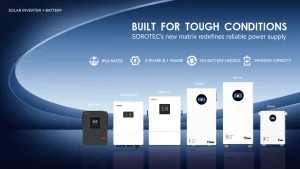Picking a battery for an inverter or solar power setup goes beyond tech specs. It deals with everyday trust, costs over time, and how the setup works in actual situations. For houses, small workplaces, or big factory systems, people often look at two kinds of batteries — AGM batteries and tubular batteries. Both store energy, yet they operate differently and have unique strong points.
SOROTEC, a reliable maker of power gear since 2006, creates inverter and battery setups like the REVO Series and SL Battery Series. Knowing how AGM and tubular batteries work with current inverters can help you pick the best one much easier.

What Are the Main Differences Between AGM and Tubular Batteries?
At a glance, AGM and tubular batteries look similar. Both are lead-acid types, but their inside build and how long they last differ a lot.
AGM Battery Construction and Working Principle
AGM (Absorbent Glass Mat) batteries keep the liquid inside slim glass fiber mats. This closed design stops spills and makes the battery safe and small. Since it does not leak, you can put an AGM battery in various spots. This helps for tiny inverter setups or ones you carry around. They also fill up fast, which works well for brief power backups.
Tubular Battery Design and Deep-Cycle Capability
Tubular batteries have long tube-shaped positive plates packed with lead oxide. The liquid moves freely inside. This setup keeps the key parts steady, cuts down on wear, and boosts life span. People know tubular batteries for their strong deep discharge power. So, they give steady energy for many hours. This makes them great for solar setups or places with long power outs.
Comparison of Lifespan, Efficiency, and Maintenance
AGM batteries need almost no upkeep and are simple to use. But they often last 3–5 years. Tubular batteries ask for adding clean water now and then. Yet they can go for 7–8 years or more. In spots with lots of power cuts, tubular batteries usually prove more steady.
How Do These Batteries Perform with Modern Inverters?
How well a battery setup runs ties closely to the inverter it pairs with. New hybrid and off-grid inverters — like SOROTEC’s REVO HMT and REVO VM IV — support both AGM and tubular batteries.
Compatibility with SOROTEC REVO Series Inverters
SOROTEC’s REVO inverters make pure sine wave power, handle big surges, and charge batteries in a smart way. These traits fit both battery kinds. However, tubular batteries deal better with long and deep discharge rounds. When linked with REVO HMT, they give solid backup during longer blackouts.
Charging Efficiency and Communication Features (RS485/CAN)
The REVO HES and HMT models include ports for talking (RS485 and CAN). These let you control how the battery charges better. Tubular batteries gain from this by keeping even voltage and dodging too much charge. On the flip side, AGM batteries fill up quicker. They suit short, repeated backups in homes or small offices.
Performance Under Different Power Demands and Load Types
AGM batteries work fine in setups that run lights, internet boxes, or other light stuff. Tubular batteries are made for tough jobs — like running machines, health tools, or solar setups that go every day. They manage longer run times without dropping power.
Which Battery Type Is More Suitable for Solar and Backup Systems?
Each inverter setup has its own goal. Some only kick in during power fails, while others help with daily sun power.
AGM Batteries for Compact Residential Use
AGM batteries fit well in smaller spots where room is tight and folks want clean, easy power. They match nicely with small SOROTEC models like REVO VM II PRO or REVO VP/VM. These are light but strong.

Genus Tubular Batteries for Long-Duration Power Backup
In places where power goes out a lot, tubular batteries do best. Paired with SOROTEC REVO HES inverters, they keep bigger loads going — from fridges and pumps to small shop tools — for many hours.
Application Scenarios in Off-Grid and Hybrid PV Systems
Tubular batteries are perfect for solar setups that run daily, especially in off-grid or mixed ones. When joined with SOROTEC MPPT solar inverters, they hold more energy, last longer, and handle hard spots better than AGM batteries.
How Does the Total Cost of Ownership Compare?
Cost is more than just the buy price. It also covers how long the battery lasts and upkeep costs over years.
Initial Investment and Replacement Cycle
AGM batteries cost less at first, but you replace them more often. Tubular batteries ask for more money upfront. But they give longer life and fewer swaps. This makes them cheaper in the end for heavy jobs.
Energy Efficiency and Operating Cost over Time
Tubular batteries can go deep without big harm. This lets them give more useful energy each time, which cuts running costs. When matched with REVO HMT inverters, they offer good work with steady power flow.
Value of Reliability in Industrial and Commercial Settings
In factories where power loss hurts — like making goods or data spots — trust matters more than cheap prices. Tubular batteries, with their tough build, can take high loads. They bring the steady work these places need.
What Role Do SOROTEC Solutions Play in Improving Battery Performance?
SOROTEC does not just sell parts. It makes full energy setups that team up well.
Intelligent Battery Management through REVO HES and HMT Inverters
These inverter types can tweak the charging based on battery state and heat. That helps both AGM and tubular batteries last longer and run more even.
Advanced MPPT and Load Management Functions
The inverters use MPPT (Maximum Power Point Tracking) to pull more energy from sun panels. Dual load output keeps key devices on first. So, you do not lose important gear during cuts.
Real-Time Monitoring via Wi-Fi and Remote Platforms
SOROTEC setups let folks check energy use, charging, and load info through Wi-Fi or far-off spots. This cuts time on fixes and helps spot problems before they stop work.
How to Choose the Right Battery for Your Specific Application?
Picking the best battery rests on power needs, surroundings, and how much you use it.
Evaluate Load Requirements and Backup Duration
If power cuts stay short, AGM batteries do okay. For longer outs or daily runs, tubular batteries give more even backup time.
Match Battery Type with Inverter Model (REVO VM IV, HMT, etc.)
Teaming the right inverter with the right battery is vital. Models like REVO VM IV suit homes well. Meanwhile, REVO HMT fits bigger or business setups.
Consider Climate, Installation Space, and Maintenance Capability
Hot weather cuts battery life. Tubular batteries handle heat better, while AGM batteries do fine in cooler spots. If the place cannot handle regular checks, AGM might be the simpler pick.
Why Partner with SOROTEC for Your Energy Storage Needs?
Going with SOROTEC means more than grabbing a battery or inverter. It means getting a full, trusty power fix.
Proven Quality and Global Certifications
SOROTEC’s goods hold CE, ISO, and IEC marks. Folks trust them in over 100 lands across fields like phone links, health care, and green energy.
OEM/ODM Support for Custom Energy Solutions
The firm gives design and tweak options for folks who need special energy setups — from voltage changes to fits for different spots.
Reliable After-Sales Service and Technical Assistance
SOROTEC brings long-term tech help and fix aid. This ensures every setup stays steady and keeps working.
FAQs
Q1: Can AGM and tubular batteries be connected together?
A: It’s not advised. Mixing them causes uneven charging because they have different chemical properties and charge rates.
Q2: How often should tubular batteries be checked?
A: Every few months. The water level should be topped up when it’s low. Systems from SOROTEC can send alerts to remind users.
Q3: Which inverter size works best with Genus tubular batteries?
A: For homes or small businesses, 3–6 kW models like REVO VM IV or REVO HMT are ideal. For larger setups, multiple units can be installed in parallel to increase total output.








